Vic Smith: Early Photographer of the Bentleigh Area
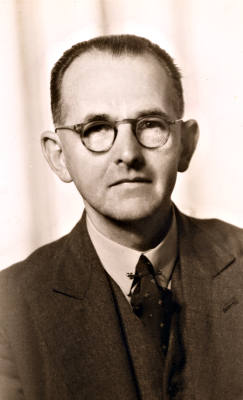
Victor Cyril Smith c1960. Courtesy Helen Stanley.
Vic Smith was the fifth child of John Logan Smith and Mary Ann (Minnie) Smithy, nee Allnutt; pioneers of the Bentleigh area. Vic was actually christened Cyril Victor Smith, however, he rejected that name vehemently very early in his life, and thereafter was always know as Vic Smith, or V C Smith, to his friends and family.
For most of his life Vic lived in the Bentleigh area, so named in the 1900s after Tommy Bent, a Member of Parliament, and President of the Shire of Moorabbin. Previously, in the 1800s when Vic was born, that area was known as Brighton East. He grew up with his parents, in a close-knit family surrounded by his two elder sisters, Jessie and Eva and his brothers Archie, Tom and Harry. Much of his extended family of cousins, aunts and uncles also lived close by. As a boy and teenager Vic was particularly close to his youngest brother, Harry who was three years his junior. The Smith family were Methodists and they all adhered strictly to attending church on Sundays, and observing that the Sabbath was kept holy; time was spent in a sober fashion such as quietly reading. No work was to be undertaken on Sundays. Early on, the Methodist church led a Temperance Movement, and true to their upbringing, no member of the J L Smith’s family every touched ‘the demon drink’. On a lighter side, the church community also provided social activities for the small community and some of these are captured in Vic’s photographs showing picnics at Sandringham beach, and the trip to a Sunday School Picnic with church members seated on pews, in the back of a lorry.
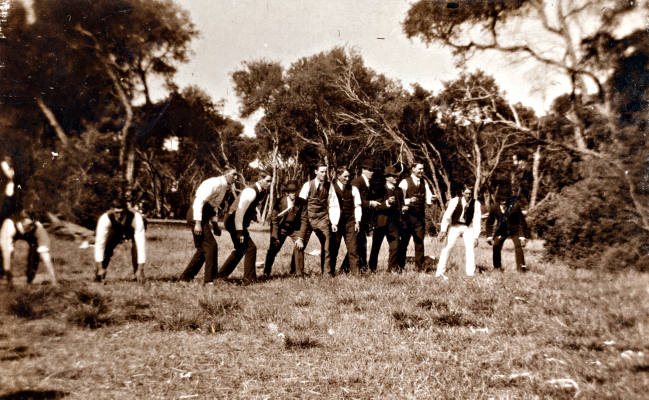
Men line-up for race at the Bentleigh Methodist Church picnic at Sandringham. Courtesy Helen Stanley.
Vic’s father, J L Smith, had started a wood merchant business at the corner of Centre and Jasper roads, Brighton East/Bentleigh in 1890. This later expanded into a prosperous Hay and Grain Store. Even later, with the demise of horse drawn vehicles, and the advent of cars, a garage was built and operated successfully. Vic’s photographs show how the first Hay and Grain Store, a single shed, gradually evolved, with the addition of a veranda, then extensions, and finally a new, modern motor car garage was built on the opposite corner. Further photographs show the demolition of the garage following its sale to Safeway supermarket.

L J Smith’s Grain and Produce Store corner of Centre and Jasper Roads, c1910. Courtesy Helen Stanley.
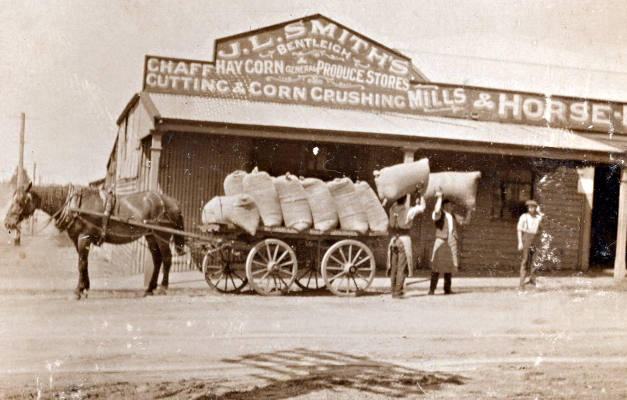
L J Smith’s Store c1920. Courtesy Helen Stanley.
As was the custom, the Smith boys finished school at twelve or thirteen years of age. Then they all commenced work in the family business, working alongside their father at the Hay and Grain Store. Horses were still the main means of transport, and Vic and his brothers worked with their father’s horses, assisted customers with loading drays and the usual generally heavy, largely manual work, required to keep the prosperous business running. Vic who was also known for his beautiful Copperplate writing, a much admired talent in the early 1900s helped to keep the Stores books.
As a teenager , in the early 1900s prior to the First World War, Vic first became interested in the newly emerging hobby of photography. From this time on he took an enormous number of photographs of the developing Bentleigh area, most of these also included his family, friends and some local traders seen undertaking their daily tasks. Vic really enjoyed his photography hobby, but as time went on, I believe he may also have been aware of the value of recording those sights for the future. Many of the photographs show the old Brighton East area, as largely rural with unmade roads. In some early photographs you can see the gas light and hitching post on the corner of Centre and Jasper Road corner. Vic always had a sense of fun, and this can be seen in the photograph of the overloaded lorry tipping up onto the rear axle. The onlookers were clearly amused! Perhaps a more artistic side of his nature is seen in the photograph of the old rusted out lorry, abandoned in a paddock? Many of Vic’s very interesting photographs capture the characters, dress, activities and customs of the early 1900s and the development of the Bentleigh area.
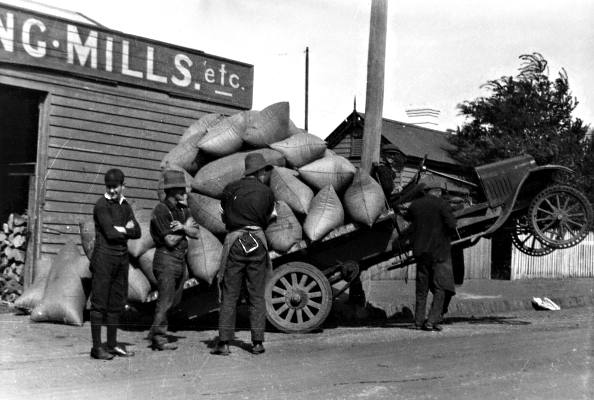
Overloaded truck outside J L Smith’s produce store. Courtesy Helen Stanley.

Rusted out old Ford. Courtesy Helen Stanley.
At the outbreak of the First World War in 1914 Vic eagerly volunteered at the YMCA to assist with the war effort. Then, as soon as he was eighteen years of age, he joined the signaller’s corps of the Australian army. At the end of this terrible war he returned home and like most of the World War I veterans never discussed his war experiences. One can’t imagine the horrors this eighteen year old experienced. It is interesting to note that when on leave during his overseas service Vic took only tourist type photographs. He took no photographs of his overseas army service. There are some photographs of Vic and the troops returning home on the troopship Sydney in 1919. Sadly Vic was affected by a chronic health condition after World War One and because of this he felt it was better to remain a bachelor.

Australian soldiers returning home from the World War One conflict. Courtesy Helen Stanley.
On returning home Vic continued to work in the family business, however possibly affected by his wartime experiences, he now proclaimed himself a philosopher. He joined or formed a group known as Philosophy Students (Regd) and became their secretary.

J L Smith garage on the corner of Centre and Jasper roads 1935. Courtesy Helen Stanley.
Whilst throughout his life Vic always adhered to all the Christian principles he had held since his Methodist upbringing, he, interestingly, went on to develop a belief in re-incarnation, and also studied astrological charts. He enjoyed poetry and read widely. Later in life he learnt, and then taught any interested person the universal language, Esperanto. Vic believed that the whole could be united more easily if people share a common language. Esperanto was a combination type language that includes works from many languages, including some French, English and German words.
As an older adult Vic lived with his sister, Eva, in Moorabbin. Following Eva’s death, he lived on a nephew’s property at Flinders. Vic passed away peacefully in the Mornington Hospital on July 24, 1974
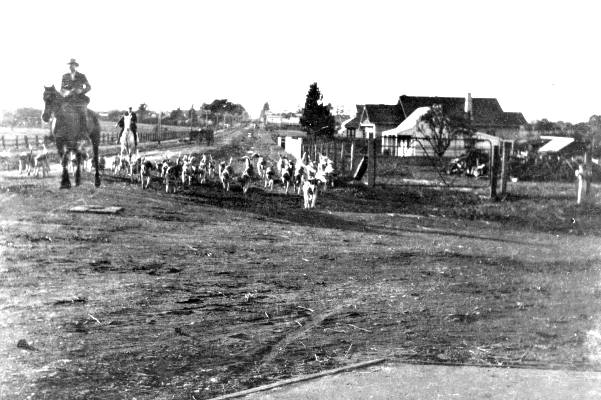
Members of the Oakleigh Hunt Club on corner of Centre and Jasper Roads. Vacant block on corner is current site of Safeway. Courtesy Helen Stanley.
